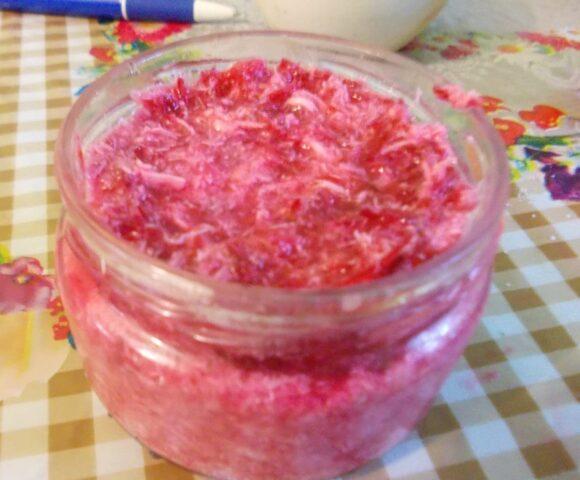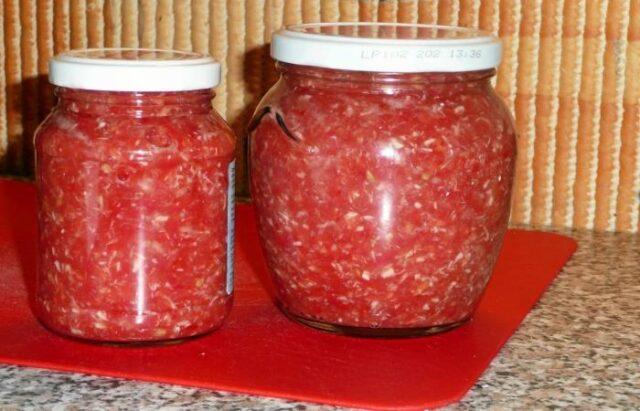Content
Horseradish stimulates the digestive system and stimulates the appetite. It is used not only in cooking, but also as a medicine for ARVI, as well as to strengthen the immune system. You need to preserve horseradish at home in winter so that it does not lose its beneficial properties until the next harvest.
Selection of raw materials for storage
Harvesting vegetable plants for the winter should be done in mid-October. If you miss time, preserving the product until spring will be problematic. Having “overstayed” its time in the ground, the root crop loses its juiciness, which affects the shelf life and taste of horseradish. When choosing a root vegetable on the market for the winter, you need to break it. If it breaks easily, it means it has already been overexposed.
For winter storage, it is recommended to choose root crops from 2-3 year old plants. The young culture is not yet as sharp as it should be. The old plant does not have a burning taste, and also has a wooden structure. It is quite simple to determine age-appropriate specimens. The diameter of such root crops is on average 2 cm.
For the winter, undamaged specimens without signs of rotting, cracks, or dents are selected and stored. If the raw material is cut or otherwise damaged, the product will quickly deteriorate. The pulp of the vegetable should be white, without inclusions. The skin of the root vegetable suitable for storage is smooth and yellow in color.

Damaged horseradish roots can be preserved for the winter by canning or drying them
Preparing horseradish for storage
After removing the root crop from the soil, it is carefully freed from soil residues and sorted by size. Damaged or rotten specimens are set aside. There is no need to throw them away, they will be recycled. It is recommended to select fruits from 25 to 40 cm long for storage for the winter. The rhizomes are laid out to dry in a well-ventilated room.
Root vegetables should not be dried in direct sunlight. Under the influence of ultraviolet radiation, beneficial compounds are destroyed and phytoncides evaporate.
Horseradish storage conditions
Properly stored for the winter, the root crop will last up to 18 months. But only the first six months does horseradish have the qualities inherent in a fresh product. After this, the raw material loses its pungency and some of its beneficial microelements.
In order to preserve the vitamins and minerals in horseradish root until spring, it is important not only to correctly select raw materials, but also to ensure storage conditions.
Blank | Shelf life, months | Temperature regime, ᵒС | Conditions of detention |
Dried root vegetable | ≥12 | Up to +16 | In a glass or ceramic container with a well-closed lid. In a dry dark place |
Pickled product | ≥12 | Up to + 6 | In a refrigerator |
Canned horseradish root | Up to 8 | +2…+6 | In the vegetable compartment |
Frozen product | No more than 6-7 | — 18 | Freezer |
Fresh roots | 6 | 0 | On the wall or suspended from the ceiling |
No more than three weeks | Up to + 6 | On the bottom shelf of the refrigerator intended for vegetables | |
From 8 to 10 | +1 to -1 | Cellar or basement |
Ways to store horseradish for the winter at home
Residents of private houses in winter are better off storing horseradish in basements and cellars, sprinkled with sawdust or sand. Residents of city apartments do not have this opportunity. They have to can, pickle or freeze the product.
In the cellar or basement
The most convenient, cost-effective way to store horseradish roots until the next harvest is in the cellar. The product goes well with other vegetables stored for the winter. The main thing is that the room has proper ventilation, which will provide the necessary humidity.
In the cellar, root vegetables are most often stored in wooden containers:
- A thin layer of sand (4-5 cm) is poured onto the bottom of the box.
- Dried horseradish roots are laid out on it so that they do not touch each other.
- A layer of sand is again poured on top. Place the product.
- There may be several such layers. The final layer is sand.
Inventories are reviewed at least once a month. If any of the roots begins to deteriorate, they are removed. To prevent the horseradish from drying out, wet sand from the basement is mixed into it during inspection.

The optimal temperature for storing horseradish in the basement is 0 ᵒC, humidity – 80%
Freezing
In a product frozen for the winter, vitamins and microelements are retained in full for up to six months.
How to prepare and store peeled horseradish root for the winter in the freezer:
- Before storing the root crop, wash it well under running water and peel it.
- Place the product on paper towels and allow the water to drain.
- Blot the raw material with a napkin to remove any remaining moisture.
The root is grated or cut into pieces of the required size, placed in portioned bags, and sealed tightly.
Drying
When horseradish root is dried for the winter, the aromatic properties and beneficial components remain in the product, although not in full. After drying, they are ground into powder and used in the preparation of first and second courses. The product is added when preparing sauces and soups.

An hour before cooking, the required amount of product is soaked in a small volume of water.
Algorithm for preparing and drying root vegetables for the winter:
- The root, washed from the ground, is peeled.
- The product is cut into slices and laid out on a baking sheet in one layer.
- The tray with the crushed root is sent to the oven, heated to a temperature of 60ᵒC.
- Drying will take from 60 to 90 minutes. Readiness is checked by touch; the horseradish should become hard.
- After cooling, the slices are ground in a coffee grinder or using a blender.
Horseradish root powder can be stored for two years. Store the product in a hermetically sealed glass or ceramic container. The workpiece is kept in a closet, away from sunlight and open heat sources. The dried root will begin to deteriorate if even a minimal amount of moisture gets into the container. During cooking, it is recommended to scoop out the seasoning with a dry spoon.
Canning
Preservation is a good way to preserve dug horseradish at home for the winter, so that you can later use it as a complete addition to dishes. Marinating and salting require some labor and time, but the results are worth it. Before filling the jars, they are sterilized.
Methods for harvesting root vegetables for the winter:
- With beets. 500 g of grated horseradish is poured with boiling water and covered with a lid. When the liquid has cooled, it is drained. Add 300 g of boiled beets, grated, 30 g of salt, 25 g of sugar, 125 ml of 6% vinegar to a container with chopped root.
- Horseradish with tomatoes. For 1 kg of tomatoes, minced through a meat grinder, take 300 g of grated horseradish, 100 g of garlic passed through a press. Add a teaspoon of salt and sugar and 60 ml of table vinegar to the mixture. The jars are closed with plastic lids.
- Classic recipe. 1 kg of root vegetables are ground in a meat grinder, 30 g of salt and 50 g of sugar are added. The workpiece is poured with boiling water and stirred. The horseradish is placed in jars, and lemon juice is added to each of them at the rate of 1 teaspoon per 200 ml of volume.
Such blanks are sent to a cool, dark place for storage.
How to Keep Horseradish Roots Fresh in the Refrigerator
Fresh storage of horseradish roots in the refrigerator is possible for no more than one month. Only those whose length does not exceed 30 cm are suitable. After digging, the root crop is cleared of soil and dried. Each root is wrapped in cling film and several holes are made in it so that air can circulate freely. The roots are placed in the vegetable storage compartment.
How to keep horseradish root fresh for a long time
Root crops stored for the winter are periodically inspected.If the product begins to deteriorate, it is removed from the total mass. Fruits suitable for further consumption are treated with antifungal agents. As the sand dries, moisten it with a spray bottle. The same procedure is carried out if the raw materials begin to dry out.
Conclusion
You can preserve horseradish in winter at home in different ways, each of them has its own advantages and disadvantages. For city residents, storage in the freezer or canning is more suitable. The easiest way for owners of private farmsteads is to put root vegetables in the basement or cellar.











